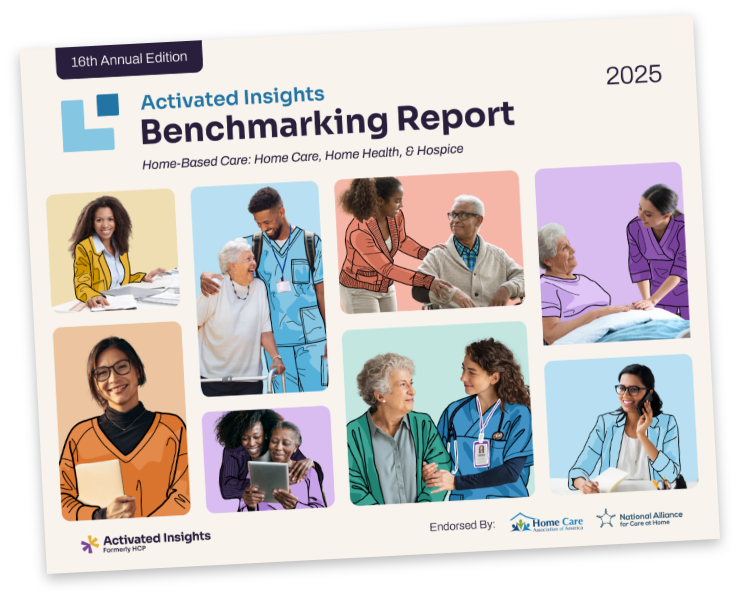Staff retention and turnover continue to be one of the biggest challenges faced by senior living providers. This article explores four factors that keep your employees on the job and how you can implement them at your location.
Activated Insights undertook an employee retention study that gathered individual-level data on over 100,000 employees across 12 senior living operators.
This article reveals the four drivers of employee retention in senior living that were discovered in the study, with detail behind the statistically significant factors within each driver category. We’ll also provide tips on how you can use these findings to reduce employee turnover.
Helpful definitions:
- Employee turnover is defined as those employees who leave within a period of time. This may include multiple terminations per job role within the same period.
- Employee retention is defined as those employees who stay within a period of time (typically calculated annually).
- Direct care workers are employees who directly care for seniors, such as certified nursing assistants (CNAs), patient care assistants (PCAs), and medical technicians.
- Front line workers are employees who do not provide direct care and who are contributors in senior living but not supervisors; this includes dining servers, housekeepers, bus drivers, etc.
Senior Living Staff Retention Driver #1: Job and Organization Characteristics
Roles and jobs within senior living range from healthcare to hospitality to those specific to aging services. As a result, job characteristics are very useful for senior living operators to examine. When investigated alongside a multitude of other factors, the job or role someone is hired into likely drives employee retention.
- Employees in direct care and frontline roles are more likely to leave. These jobs include caregivers, nursing assistants, and personal care aides.
- Employees in managerial roles, whether frontline supervisor or mid-level manager, are more likely to stay.
Relatedly, within our data models, one of the most important driving predictors of employee turnover was organizational characteristics. Ultimately, this encompasses the fact that different organizations have different cultures and different operating models. In our national dataset, baseline rates of employee retention six months after hiring range from a low of 40% to a high of nearly 70% by organization. This organizational variability in itself appears to drive retention or turnover of individual employees.
How To Use These Findings:
Providing pathways for personal growth through career ladders can be especially helpful for creating the kind of organizational characteristics that retain senior living employees.
Senior Living Staff Retention Driver #2: Individual Characteristics
When an individual thinks about searching for another job, he or she will first evaluate their personal situation to determine if they are happy or not. Factors most often considered in senior living are the employee’s family situation and commute time.
Individual characteristics that impact the decision-making process include:
- Additional responsibilities for family members outside of the job
- Distance from home to work and the availability of public transportation options to get to work.
Note: Protected personal data such as race, gender, age, disability, and sexual orientation were shown to have no bearing on prediction accuracy.
How To Use These Findings:
Employee retention and effective scheduling often go hand in hand. Supporting flexible schedules or helping with personal caregiving and commuting conditions tend to retain senior living employees at a higher rate.
Senior Living Staff Retention Driver #3: Job Satisfaction
Decades of research have shown that job satisfaction impacts employee retention. Likewise, job dissatisfaction often leads employees to think about leaving their position. Our study findings are in line with prior research data showing that happier employees stay at higher rates. However, our study of senior living employees uncovered several specific areas of job satisfaction that drive higher employee retention.
How to Use these Findings:
When we look at what drives employee retention in senior living, the following determinants of job satisfaction stand out:
- Purpose: Employees who say that “this is not just a job” and “I feel like I make a difference here” are more likely to stay.
- Expected tenure: Employees who feel like they want to work at the organization for a long time tend to stay longer.
Senior Living Staff Retention Driver #4: External Environmental Factors
Our study accounted for several external factors, including size of the metropolitan, state, and regional economies; weather; and even presidential administration changes. The most significant factor driving employee retention was that of compensation—but only when relative and nested in a local market. In particular, the findings include:
- Local marketplace matters: Compensation has an impact on employee loyalty and satisfaction. However, the absolute wage—that is, whether the rate is $12 or $12.50 an hour—has significantly less effect on employee retention than does the wage relative to what that role’s required skills command in the local marketplace.
- Skill set makes an impact: Specifically, the pay level of a job relative to what that skill set commands in the local market is very significant and impactful on employee retention. For example, if security guards at a senior living community can find a similar role that pays more at another organization in the same geographic market, then they are more likely to think about and take action to apply for the other job.
How To Use These Findings:
It’s imperative that you compare wages for similar roles and pay within market rates a a senior living operator. Employees report that absolute pay rates matter less–and pay relative to what others in similar roles make is more important. In other words, if an employee can find a comparable role elsewhere that pays more, then the wages matter to employee retention.
How Senior Living Operators Can Use These Findings to Improve Staff Retention
To address the employee turnover challenge in senior living, data must inform action. We recommend a two-part strategy:
1. Get Your Table Stakes in Order:
- Measure your company culture: Know your Great Place To Work score and how to improve the feeling of “purpose” in work.
- Use benchmark pay data for each role in each local market: Compare wages for similar roles and pay within market rates. While national and regional data is available, local data is shown to be the most important for retention.
2. Develop Workforce Retention Programs:
- Hire candidates more likely to stay: Given two equal candidates, hire the person who lives closer to work.
- Create career paths: For frontline and direct care staff members, having a career ladder in place can be the difference between staying versus leaving.
- Address individual barriers: Know and support personal caregiving needs and commute conditions—whether through direct support, such as Uber/Lyft vouchers, or through allowances or more flexibility in schedules and time off.
Taking Action Appropriate to Your Organization
As an industry, we have access to data and machine learning techniques to understand and begin solving challenges in workforce development, particularly focused on decreasing employee turnover and increasing employee retention. We recommend that senior living operators get and use data on their workforce and develop sustainable strategies with the help of technology to improve employee retention results. Ultimately, this leads to better care for our seniors.
Stopping the revolving doors of recruitment and retention in senior living is critical to your success as an operator. Access this free, on-demand recording to discover how to acquire and hold on to top senior living employees.
Related Posts












